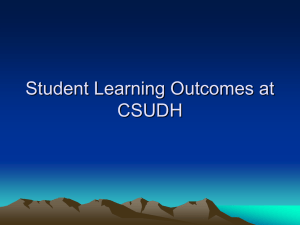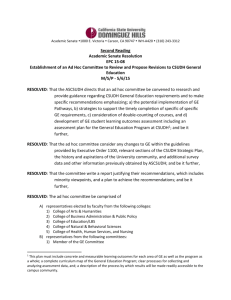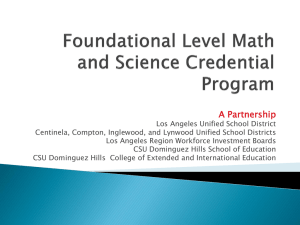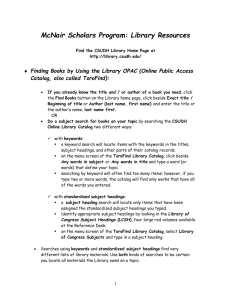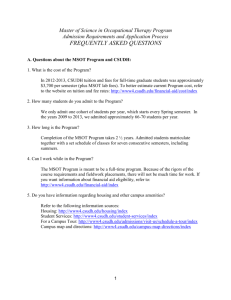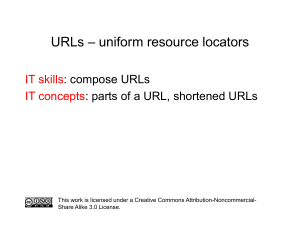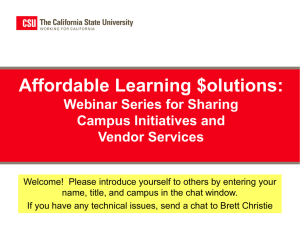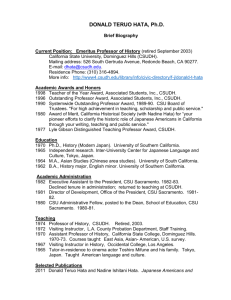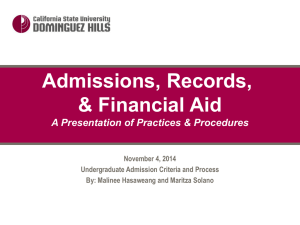Copyright 101 slide show - California State University, Dominguez
advertisement
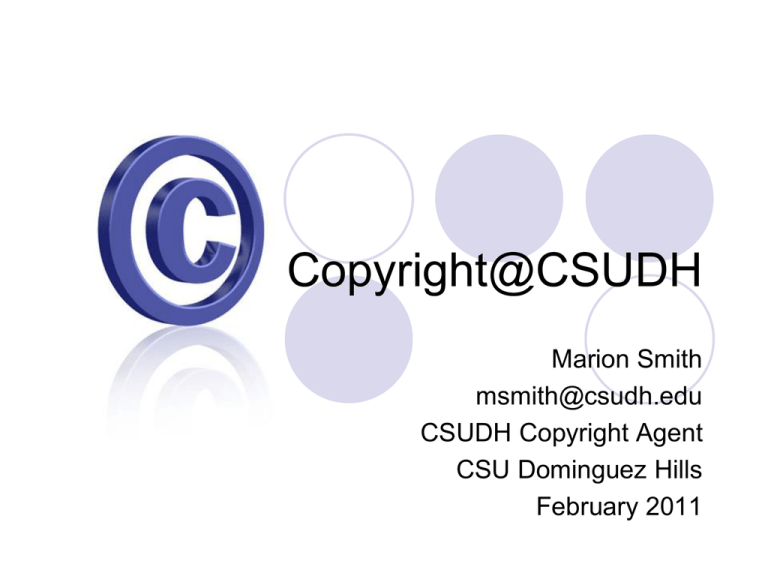
Copyright@CSUDH Marion Smith msmith@csudh.edu CSUDH Copyright Agent CSU Dominguez Hills February 2011 Copyright@CSUDH topics Define copyright Define “fair use” Define plagiarism Peer-to-peer (P2P) file sharing Current topics in the Copyright Office Copyright issues in the news Pre-test You see a terrific editorial on the L.A. Times website. It’s a perfect resource for the Political Science 101 class you’re taking/teaching, so you copy it to your course paper/website. This is “fair use”, isn’t it? What is copyright? “To promote the progress of science and useful arts, by securing for limited times to authors and inventors the exclusive right to their respective writings & discoveries." Article I, Section 8, U.S. Constitution (1789) The Copyright Act of 1976 is the primary basis of copyright law in the United States. Issues introduced by the Internet are addressed in the Digital Millennium Copyright Act of 1998 (DMCA). What works are protected? Copyright protects "original works of authorship" that are "fixed in any tangible medium of expression" (Section 102), e.g., books, photographs, movies, software, websites, music, sound recordings, architecture Not protected: Facts, slogans, titles Works of the U.S. [not state] government So who’s the owner? The creator, unless it’s a “work made for hire”: A work specially ordered or commissioned for a purpose listed in copyright law, if the parties agree in writing that it’s a work made for hire. What are my rights as copyright owner? Reproduce Prepare derivative works Distribute to the public * Publicly perform Publicly display * This is the issue with file-sharing. True or false? If it doesn’t have a copyright notice, it’s not copyrighted False: Almost anything created privately and originally after April 1, 1989, is protected. Always assume that a work is protected unless you know otherwise. On the other hand, including a notice reminds everyone that your work is protected. Here’s a sample notice: “© [dates] by [author/owner]” What about registration? Required if you are going to seek a claim of violation Register through the Copyright Office, http://www.copyright.gov/ Basic registration fee: $65 (or $35 if you file online) Post test. My posting of the L.A. Times editorial [slide 3] was fair use. Probably false: Be very careful about fair use. It’s a complicated doctrine that was dramatically altered following the advent of the Internet. What exactly is “fair use”? Under the fair use doctrine of 1976, you can use limited portions of a work for purposes such as commentary, criticism, news reporting, and scholarly reports. There are no specific rules about the number of words, the number of musical notes, or the percentage of a work. But please note: Fair use is a legal defense, not a right. The four factors of fair use 1. The purpose and character of your use (called the “Transformative Factor”); 2. The nature of the copyrighted work; 3. The amount and substantiality of the portion taken; and 4. The effect of the use upon the potential market. The Technology, Education and Copyright Harmonization (TEACH) Act of 2002 Copyright protected materials can be used in distance education—on websites and with other digital means—without permission from the copyright owner and without payment of royalties For accredited, non-profit U.S. educational institutions Required: instructor oversight The instructor is ultimately responsible for their use of copyrighted works. The materials must serve educational pursuits and are not to be used as entertainment or for any other purpose. CSUDH Library’s eReserves The University Library established eReserves in the Fall 2010 semester. Strict guidelines are posted on the library’s website, http://library.csudh.edu/services/reserves/ ereserves/policies.shtml. What about plagiarism? Copyright There can be a copyright infringement even if the source is properly acknowledged. Is addressed in federal statutes and case law. Plagiarism May be grounds for federal legal action because of the copyright infringement. In an academic environment, a violator can also be subject to academic discipline. Peer-to-peer (P2P) file sharing A warning from the CSUDH Intelligence Community Center of Academic Excellence: “Illegal music downloads are viewed in the same manner as illegal drug use. Countless students have been denied employment and/or security clearances because of the illegal music stored on their iPods.” Current Topics in the Copyright Office Anti-Circumvention – Section 1201 The “jailbreak” ruling The Google Book Settlement Orphan Works – Section 108 The “jailbreak” ruling U.S. Copyright Office ruled on anticircumvention in July 2010; “jailbreaking” was the piece of the ruling that made the news. Jailbreaking an iPhone or other mobile device will no longer violate federal copyright law. Anti-Circumvention – Section 1201; legal circumvention now also includes: 1. Short clips from DVDs where the circumvention is accomplished solely for incorporation of short portions of motion pictures into new works for the purpose of criticism or comment to meet the goals of fair use for: Educational uses by college and university professors and by college and university film and media studies students; Documentary filmmaking; Noncommercial videos. More Legal Circumvention 2. The jailbreak ruling. 3. Computer programs that enable used wireless telephone handsets to connect to a wireless telecommunications network with the permission of the network owner. More Legal Circumvention 4. Technological protection methods on computer-based video games, when circumvention is accomplished solely for the purpose of good faith testing for, investigating, or correcting security flaws or vulnerabilities. 5. Computer programs protected by dongles that prevent access due to malfunction or damage and which are obsolete; and More Legal Circumvention 6. Literary works distributed in ebook format when all existing ebook editions of the work contain access controls that prevent the enabling either of the book’s readaloud function or of screen readers that render the text into a specialized format. Google Book Settlement The Copyright Office is unhappy about the Google Book Settlement. See “Copyright Office No Fan of Google Settlement,” http://blogs.wsj.com/digits/2009/09/10/cop yright-office-no-fan-of-google-bookssettlement/?blog_id=100&post_id=6536, posted September 10, 2009. Orphan Works – Section 108 Orphan works probably comprise the majority of the record of 20th century culture. An orphan work is still presumably under copyright, but the copyright owner cannot be found. The Copyright Office recommendation… That any use of an orphan work include attribution if at all possible; this reminds the user that the copyright owner might exist. Should the use of the work be challenged, the user must prove that a reasonable search was performed—and stop using the work immediately (i.e., take it off a server). In the news… China and U.S. software CSU Sacramento’s Ryan Stevens NoteUtopia.com website Shepard Fairey and the HOPE poster Online Resources The Copyright Office, http://www.copyright.gov/ “The TEACH Act Finally Becomes Law,” http://www.utsystem.edu/ogc/intellectualpr operty/teachact.htm Copyright Clearance Center (CCC), http://www.copyright.com CSU and CSUDH Resources CSU Executive Order 999 - Illegal Electronic File Sharing and Protection of Electronic Copyrighted Material, http://www.calstate.edu/EO/EO-999.html CSUDH Copyright Website, http://www.csudh.edu/copyright/ CSUDH Library Reserves and eReserves Portal, http://library.csudh.edu/services/reserves/
